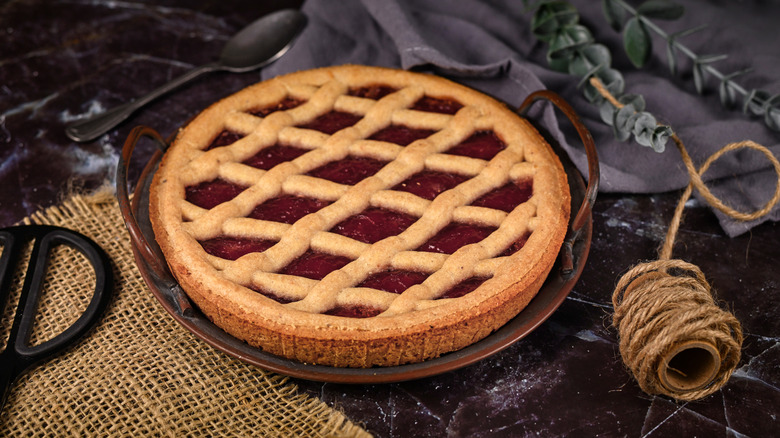How Austria's Linzer Torte Inspired A Beloved Cookie
The Linzer torte is more than just a delicious dessert. Famed for its almondy latticework crust and jammy filling, the Austrian specialty is also historically significant, as the 1653 recipe left by the Countess Anna Margarita Sagramosa is thought to be the world's oldest surviving cake recipe, according to Cakes and Bakes.
The torte's association with Linz, Austria, its namesake, is also noteworthy. MasterClass says that these iconic tortes have been baked in the city for more than 300 years. Jindrak, a confectionery based in Linz for nearly a century, says on its website that the cake has been known by its Linz-inspired moniker since at least 1696 when the city was known for its talented women bakers.
In the years since, the name Linzer has been given to more than just a beloved cake, of course; Linzer cookies, another delicious dessert, also bare the name.
How Linzer cookies came about
Linzer cookies – which are also referred to as Linzer "eyes" (or Linzer augen) because of the cutouts displaying the colorful jam inside (per Joy of Baking) — are likely a derivative of the original torte and have become beloved in their own right. The cookie version boasts the same almond-flavored dough and jammy filling as the original torte, observes The New York Times, albeit with a dusting of powdered sugar. Cookies in general are believed to have originated during the 7th century as a small-scale testing method for cakes, says What's Cooking America. Thus it's possible that Linzer cookies evolved in this fashion, especially given the similar ingredients used in Linzer tortes and Linzer cookies.
Since as Taste of Austria points out, the Linzer cookie has always been viewed as a "miniature cousin" to the older, larger, and more famous Linzer torte, its history has inspired far fewer origin stories. However, Das Grüne Archiv credits the husband and wife baking team of Johann Konrad Vogel and Katherine Kress. The duo first popularized Linzer "Eyes" in Linz after Vogel moved to the Austrian city in 1822. Over the course of succeeding decades, the pastry cookie began making its way around the world, gaining favor in countries such as Germany, Switzerland, and England, where it became known as a Linzer biscuit.
Eventually, Linzertortes would make it to America via Austrian immigrants. According to the Wisconsin Historical Society, Franz Holzhulber, an Austrian artist traveled to Wisconsin during the 1850s, and after losing both his belongings and a promised job, he briefly turned to baking the tortes to support himself. It's believed that either Holzhulber or another Austrian immigrant introduced Linzer cookies at about the same time (per eat2explore).
It's been a long journey for Linzer cookies to make around the world, and it (probably) all started with the Linzer torte.

